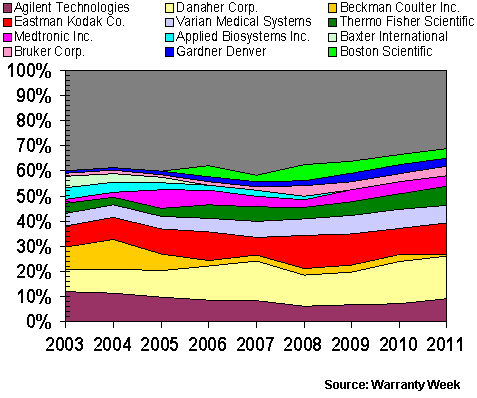Medical & Scientific Equipment Warranties: While it's true that systems using lasers or X-rays generate more than their fair share of warranty expense, it's also true that their manufacturers have been among the most successful warranty cost-cutters in recent years.
Among all the makers of medical equipment and scientific instruments, some of the companies with the highest warranty expenses have also done the most to reduce their warranty costs.
It turns out that the makers of laser- and X-ray-based medical and scientific equipment typically suffer from higher rates of warranty expense than other medical equipment and scientific instrument makers. But they've also done the most in recent years to raise the reliability levels of their products and reduce the inefficiency of their warranty process.
To be sure, the laser- and X-ray-based equipment makers account for only 10% to 15% of the total warranty expenses in the medical/scientific industry, depending upon the year and the metric examined. But they also tend to spend a higher percentage of their sales revenue on warranty work than their peers whose equipment does not involve either lasers or X-rays.
Claims Increase
In Figure 1, we're tracking the amount of claims paid per year by the 155 medical and scientific equipment manufacturers we've been following since 2003. The total amount of claims paid was up by about 6.5% in 2010-2011. But it was actually down by 4.8% for just the 22 companies that make equipment that uses lasers or X-rays.
Figure 1
Medical & Scientific Equipment Warranties
Claims Paid by U.S.-based Companies
(in US$ millions, 2003-2011)
Both the laser/X-ray manufacturers and the others saw claims payments fall in 2009 and again in 2010. So the increase by the non-laser/non-X-ray manufacturers reverses that trend.
However, notice also that there were declines in claims paid in both 2006 and 2007. And during both those years, claims paid by the laser/X-ray manufacturers actually grew. Still, 2008 continues to be the peak year for claims paid.
Biggest Changes in Claims Payments
Among the top warranty providers in the medical equipment industry, some of the biggest annual claims payment reductions were reported by Hologic Inc., MTS Systems Corp., Hill-Rom Holdings Inc., and Medtronic Inc. Meanwhile, some of the largest increases in claims payments were reported by Steris Corp., Agilent Technologies Inc., Bio-Rad Laboratories Inc., and Roper Industries Inc.
For accruals, as can be seen in Figure 2, the peak year was actually 2005. Accruals by all medical and scientific equipment manufacturers fell in 2006 and 2007, although accruals by the laser/X-ray manufacturers grew in both years. And then accruals rose in 2008, but not to the same level as in 2005.
Figure 2
Medical & Scientific Equipment Warranties
Accruals Made by U.S.-based Companies
(in US$ millions, 2003-2011)
Medtronic and MTS Systems also managed to reduce their accruals by large amounts. Others doing likewise included Varian Medical Systems Inc. and Boston Scientific Corp.
On the flip side, Steris was also among the companies reporting the largest increase in accruals. On that unfortunate list, it was joined by Life Technologies Corp., Invacare Corp., and Roper Industries Inc., among others.
Accruals Rise in 2011
Accruals for all medical manufacturers grew by 7.4% in 2010-2011, from $678 million to $727 million. But once again, accruals by laser/X-ray manufacturers declined, while increasing for their non-laser/non-X-ray peers.
The reason for this seems to be the continuous improvement in the efficiency of the warranty process by the laser/X-ray manufacturers. While they consistently cut their warranty expense both in dollars and as a percentage of sales revenue, their non-laser/non-X-ray peers did not.
To show this, we've taken the expense data from Figures 1 and 2 and divided it by sales data. In Figure 3, we're taking the industry total expense data and dividing it by total sales. In Figure 4, we're making those calculations separately for the 22 laser/X-ray manufacturers and the 133 non-laser/non-X-ray manufacturers.
In Figure 3, there's been a slight improvement in the overall expense ratios, with manufacturers paying roughly 0.9% to 1.0% of sales back in 2003-2006, but reducing that to a range of 0.7% to 0.8% in 2009-2011. That's encouraging, but not dramatic. In past weeks, we've shown how other industries such as computers and telecom equipment have cut their warranty expenses in half. That's dramatic.
Seasonal Trend
Notice, however, that the data for the medical and scientific equipment industry seems to follow a highly seasonal pattern, peaking in the third quarter and hitting lows in the first half of each year. This, we've been told by industry experts, has lots to do with the purchasing cycles of universities and teaching hospitals, which each summer are getting ready for the new school year to begin.
Figure 3
Medical & Scientific Equipment Companies
Average Warranty Claims & Accrual Rates
(as a % of product sales, 2003-2011)
Now, let's separately chart the claims and accrual rates of the 22 laser/X-ray manufacturers and the 121 others. Remember, from the data in Figures 1 and 2, that the laser/X-ray manufacturers account for only 10% to 15% of the dollars spent on warranty. Yet in Figure 4 it's clear that they spend much more per sales dollar on warranty work.
In fact, back in 2003-2006 they were spending roughly twice as much per sales dollar. While the non-laser/non-X-ray manufacturers were spending 0.8% to 1.1% of their sales revenue on warranty, the laser/X-ray manufacturers were spending 1.6% to 2.2% of their sales revenue on warranty.
Figure 4
Medical & Scientific Equipment Companies
Average Warranty Claims & Accrual Rates
Laser & X-ray Equipment vs. Other Equipment
(as a % of product sales, 2003-2011)
The thing is, the laser/X-ray manufacturers did something about their expenses. Every year since at least 2005, the laser/X-ray manufacturers have reduced their warranty expenses as a percentage of sales. By 2001, they were paying between 0.8% and 1.4% of sales for warranty work (the data remains highly seasonal). At times there are only a few tenths of a percentage between their claims and accrual rates and the averages of the other manufacturers.
And yes, the other manufacturers also managed to cut their warranty expenses, from above 0.8% back in 2003-2006 to below 0.8% in 2010 and 2011. But that progress is not as dramatic as the change seen by the laser/X-ray manufacturers. And that's why the decline seen in Figure 3 is so underwhelming.
Among the laser/X-ray manufacturers contributing the most to the downward trend were Dentsply International Inc., which cut its accrual rate from 0.07% in 2010 to 0.03% in 2011; and Syneron Medical Ltd., which reduced its accrual rate from 4.3% in 2010 to 3.4% in 2011. Both also cut their claims rates by 15% or more, as did Sirona and Hologic.
Declining Warranty Reserves
The third metric we track besides claims and accruals is the warranty reserve fund balance. In Figure 5, we can see that the combined balances of the 155 companies in the medical and scientific equipment industry hit its maximum at the end of 2006 -- long before there was any talk of a recession. For the laser/X-ray manufacturers, the maximum balance came a year later, at the end of 2007.
Figure 5
Medical & Scientific Equipment Warranties
Reserves Held by U.S.-based Companies
(in US$ millions, 2003-2011)
Ever since the end of 2006, the industry's warranty reserves have diminished each year. Part of the reason, as was detailed in Figures 3 and 4, is the reduced need for claims payments, because the products are becoming more reliable and the process is becoming more efficient. But let's not make too much of this. The annual reductions for the entire industry have been below 2% for three years. And there have been small annual increases for both the laser/X-ray manufacturers and the others at times.
Claims "Market Share"
Finally, we wanted to show the ups and downs reported by the top dozen medical and scientific equipment manufacturers over the past nine years. In Figure 6, we've taken the totals reported for the entire industry in Figure 1, and set them to be equal to 100%. Then, we charted the annual claims payments of the top companies as a percentage "market share" of that total.
Figure 6
Medical & Scientific Equipment Companies
Claims Paid per Year
(as a % share of the total in Figure 1)
Unlike in several other industries, the smaller companies outside the top warranty providers in this instance still make roughly 30% to 40% of the claims payments. That's a sign of a lack of consolidation. In the computer and telecom equipment industries, the largest warranty providers are responsible for upwards of 80% of the claims payments.
Mergers & Acquisitions
To be sure, there have been several sizeable mergers in the industry. Thermo Fisher Scientific Inc. was formed in 2006 from the merger of Thermo Electron and Fisher Scientific. Guidant Corp. merged with Boston Scientific that same year. Agilent acquired Varian Inc. in 2009. And Thermo Fisher acquired Dionex Corp. in 2010.
In Figure 6, notice that the claims data for Beckman Coulter Inc. trails off to zero in 2011, while Applied Biosystems Inc. disappears in 2008. Beckman Coulter was acquired by Gardner Denver, and Applied Biosystems merged with Invitrogen Corp., forming a new company called Life Technologies Corp.
Life Technologies, however, no longer reports its warranty expenses in a manner that would allow us to continue including them in a chart like Figure 6. Likewise, in 2006 Baxter International Inc. decided to completely discontinue reporting its warranty expenses. And with a Securities and Exchange Commission so completely overwhelmed by more pressing scandals, apparently nobody noticed.
Ninth Annual Product Warranty Reports
As we continue with our annual survey of U.S.-based warranty providers, here are the links to the online editions of all the other parts of this series:
Readers needing more detailed snapshots of individual companies in either a PowerPoint or Excel format are invited to view the list of charts and spreadsheets available on the Warranty Statistics page.
|














